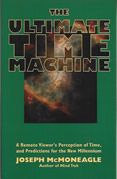|
The Ultimate Time Machine is Joseph McMoneagle's second book on the subject of remote viewing, and it is a daring attempt to explain some of the mysteries of time from the perspective of a remote-viewing practitioner. There has never been a book quite like this one, and it is worth a close read if you are at all interested in how remote viewing can transcend time. As with much of Mr. McMoneagle's writing on the subject of remote viewing, this book is a mix of philosophy, descriptions of scientific protocols encountered in laboratory experiments in which he participated, and intriguing collections of remote-viewing data. What makes this collection of RV data pertinent to the topic of time is that the targets are drawn from the past and the future. Much of the RV data that are described in this book were not collected using the stringent scientific protocols that Mr. McMoneagle describes in detail in his other writings, but this does not detract from the usefulness of this book. It appears that the purpose of this book is to allow Mr. McMoneagle to challenge his readers' assumptions of time. Actually, he seems to want to challenge the idea that time is anything more than merely an illusion, a method by which humans organize experiences in a linear string. But for Mr. McMoneagle it is clear that time is not a limiting constraint to the human experience unless humans want it to be. For many of the remote-viewing sessions presented by Mr. McMoneagle in this book, he has yet to receive target feedback, and indeed in some instances target feedback may not be possible in his lifetime. For example, he presents a transcript of an intriguing RV session in which he explores the origin of humanity, and he ends up perceiving that the Darwinian evolutionary march through time may have been punctuated by what might be called external intervention followed by long periods of abandonment. We are not told whether this external intervention is done by extraterrestrials, highly advanced spiritual beings, or whatever. But the idea is clear that human evolution may be more complicated than that which is commonly described in many standard textbooks. Similarly, he describes a session conducted at The Monroe Institute in Faber, Virginia in which the target is Jesus. The results are as fascinating as they are mysterious, and I am sure many readers will not mind that he has not been able to verify his observations. The value of this session can be found in the striking nature of the ideas which he perceives. The third part of this book contains a long listing of future prophecy which extends through the year 2100. Skeptics will be sure to point out each inconsistency in his detailed predictions when matched with the evolving historical record. But this misses the point. Mr. McMoneagle is the first to point out that identifying exact times is one of the most difficult things to do with remote viewing. It is easier to perceive an event than it is to identify when it happens. Perhaps this is due to the inadequacy of our concept of time. Perhaps the event is all that really matters, and its timing is merely a convenience of presentation. Perhaps also there are other parallel universes as suggested by Dr. Fred Alan Wolf, and others in which both events and their timings are re-arranged. Thus, my suggestion is that the reader will want to focus on Mr. McMoneagle's perceptions across time and not dwell too heavily on the exact years to which he pins those events. In particular, readers will want to look closely at his ominous prediction of a second war between the U.S. and Iraq. I should mention that future experiments with prophesy might benefit from some changes in the procedures that Mr. McMoneagle used in this long experiment (conducted over ten years) on which he reports in the third part of his book. His methodology was to write targets relating to various future events and conditions, and to place these targets in a pool of sealed envelopes. He would then randomly choose a target envelop, put it on his computer monitor, and then type out his perceptions. After he was done, he opened the envelop and read the target. When his typed perceptions did not make sense with regard to the specified target, he would discard his observations and re-enter the target in the pool. Well, I cannot tell you how many times I wished I could see those discarded perceptions. In future experiments, I strongly suggest that remote viewers not discard any perception, however strange it may be. It may be that the perception is simply inaccurate; remote viewing by anyone is rarely perfect. But it may also be that the current understanding of the future may be so alien to what actually is going to happen that we will want to hold off judgment until the complete set of data - both predictive and actual - are in. Also, it would be better to clearly separate the remote-viewing data from an analysis of the data that may draw on other sources so that the raw data can be re-examined in their pure state at a later date. None of this criticizes Mr. McMoneagle's efforts in this book. When he conducted this experiment, no one really knew how to do it. Indeed, we still do not know how to conduct the perfect prophesy experiment. But with each attempt comes the ability to improve on the method the next time around. Mr. McMoneagle's great contribution in this book is to make the attempt at all, and then to publish it so that we all may learn from his efforts. The greatest mistake was thus avoided, and that mistake would have been to file his results in a box without letting others see what he had done. Indeed, what good is private prophesy?
|

